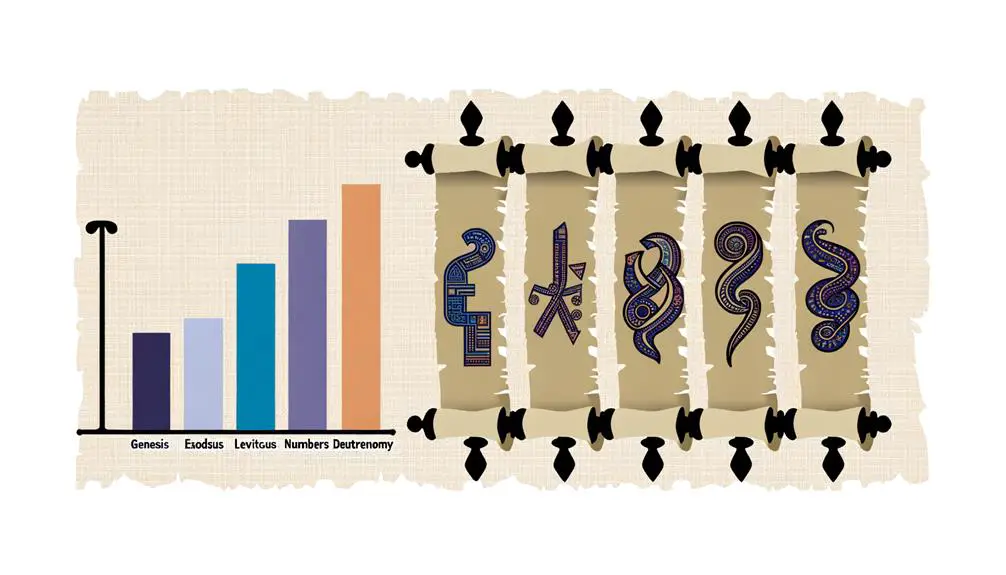From Genesis to Revelation, explore the fascinating variance in chapter counts and uncover the deeper meanings behind these numbers.

Number of Chapters per Book in the Bible
Consider the book of Psalms; it's the longest book in the Bible with 150 chapters.
You might wonder how this compares to the concise epistles in the New Testament, such as Jude, which contains only a single chapter.
This variance in chapter count across the books of the Bible isn't just a numerical curiosity—it unveils the diverse purposes and audiences these texts were written for.
As you explore further, you'll discover how these differences illuminate the historical, cultural, and theological contexts that shaped each book, offering a deeper appreciation for the Bible's multifaceted narrative.
Key Takeaways
- The Bible consists of 66 books, with the Old Testament having 39 and the New Testament 27.
- Each book in the Bible varies in chapter length, contributing to the overarching faith narrative.
- The Old Testament's historical and wisdom books offer deep insights through varied chapter counts.
- The New Testament focuses on the Gospel and Apostolic missions, structured into concise chapters for clarity.
Exploring the Old Testament

Delving into the Old Testament, you'll find it comprises a rich tapestry of history, law, prophecy, and wisdom literature, spanning 39 books with varying chapter lengths. This segment of the Bible offers not just spiritual guidance but also a window into the life and times of ancient civilizations. The historical context embedded within these texts is vital to understanding both the surface-level narratives and the deeper, underlying messages.
In your exploration, you'll encounter the Pentateuch or Torah, the first five books traditionally ascribed to Moses. These books lay the foundational legal and ethical codes for Jewish society. Following these, the historical books recount the experiences of the Israelites from their conquest of Canaan through their exile and return. Prophetic books, filled with oracles, warnings, and promises, reflect the social, political, and religious turmoil of different eras. Wisdom literature, including Psalms and Proverbs, offers insights into personal conduct and the nature of human suffering.
Archaeological evidence plays a crucial role in corroborating the historical claims made in the Old Testament. Excavations in the Near East have unearthed artifacts and inscriptions that align with biblical narratives, lending credibility to the historical accounts. For instance, the discovery of the Tel Dan Stele provides tangible proof of King David's existence, previously debated by scholars.
Understanding the Old Testament's historical context, enhanced by archaeological findings, allows for a more nuanced appreciation of its chapters. Each book, with its unique chapter count, contributes to the overarching story of faith, resilience, and identity.
Delving Into the New Testament

You'll find that the New Testament's structure is meticulously organized, providing a foundation for Christianity's core teachings.
As you explore its key themes, you'll uncover messages of love, redemption, and salvation that have resonated through centuries.
Prominent figures such as Jesus Christ, the Apostles, and Paul offer profound insights into moral and spiritual guidance, shaping the essence of Christian doctrine.
New Testament Structure
Exploring the New Testament reveals a structured compilation of 27 books, each contributing uniquely to the Christian canon and theology. This structure isn't arbitrary but reflects the theological and historical contexts of early Christianity, particularly focusing on the Gospel origins and Apostolic missions.
- Gospels: They serve as the foundation, detailing the life, teachings, death, and resurrection of Jesus Christ.
- Acts: This book transitions from the Gospels, emphasizing the spread of the Gospel through Apostolic missions, and the establishment of the early church.
- Epistles: Written by various apostles, these letters address theological issues, ethical instructions, and the practical application of the Gospel in the life of believers and communities.
This carefully crafted structure supports a deeper understanding of Christian doctrine, encouraging both scholarly study and personal reflection.
Key Themes Explored
Building on the structured compilation of the New Testament, we now examine its key themes, which are crucial for understanding Christian theology and the practical implications of faith in daily life.
Within its pages, the New Testament delves deeply into the cultural context of the early Christian community, offering insights into the societal norms and challenges faced by believers. This cultural backdrop is essential for grasping the messages conveyed through parables, teachings, and the acts of the apostles.
Additionally, the quest for historical accuracy is evident, with meticulous attention to the details of events and locations, underscoring the authenticity of the narrative. These elements together paint a vivid picture of the early Christian experience, highlighting the enduring relevance of these themes in contemporary discussions of faith and morality.
Prominent Figures Highlighted
Delving into the New Testament, we encounter a myriad of prominent figures whose lives and teachings are fundamental to Christian doctrine and the broader narrative of salvation history. These individuals aren't just central to the text's message but also provide insight into genealogical records and cultural contexts of their times.
- Jesus Christ: Central to the New Testament, His life and teachings form the cornerstone of Christianity, offering profound insights into spiritual and moral living.
- Paul the Apostle: His epistles address early Christian communities, embedding theological concepts within the socio-political realities of the Roman Empire.
- Mary, Mother of Jesus: Represents a pivotal connection between the Old and New Testaments, her story enriching understanding of faith, obedience, and the human experience within divine plans.
Through these figures, the New Testament weaves a complex tapestry of faith, history, and culture.
Highlighting the Pentateuch

The Pentateuch, comprising the first five books of the Bible, serves as the foundation for both Jewish and Christian Scriptures, encapsulating a rich tapestry of theological, historical, and moral teachings. Traditionally attributed to Mosaic authorship, these books chronicle the beginnings of the universe, the establishment of the covenant foundations between God and His chosen people, and the laws that would govern their lives. This attribution not only underscores Moses as a pivotal figure but also emphasizes the divine guidance in these writings.
Delving deeper, you'll find that the Pentateuch isn't merely a collection of laws and stories. It's an intricate narrative interwoven with covenantal themes that resonate through later biblical texts. The notion of covenant—agreements made between God and humanity—becomes the bedrock upon which the rest of the biblical narrative is constructed. These covenants, established in the Pentateuch, lay out a framework of expectations and promises that define the relationship between God and His people.
Furthermore, the detailed legislations and moral codes found within these books reflect a profound understanding of human nature and divine justice. They serve not only as historical records but as foundational texts that inform ethical and spiritual practices for countless believers. The Pentateuch's significance, therefore, lies not just in its role as the beginning of the biblical story but in its ongoing influence on religious thought and practice.
In analyzing the Pentateuch, you're not just exploring ancient texts; you're uncovering the foundational layers of two major world religions, delving into the roots of theological and moral principles that continue to shape the lives of millions.
The Wisdom Books Unveiled

Having explored the foundational Pentateuch, we now turn our attention to the Wisdom Books, a collection that offers profound insights into the complexities of human experience and divine interaction. These texts, rich in literary styles and deeply embedded in their cultural context, provide a unique lens through which to view the world.
The Wisdom Books consist of:
- Job: A narrative that wrestles with the problem of suffering and the justice of God.
- Psalms: A collection of songs and prayers that express a wide range of human emotions towards God.
- Proverbs: A compilation of sayings that offer practical wisdom for living.
Each book employs distinct literary styles that serve to convey its messages effectively. Job, for example, is a poetic dialogue that delves into the philosophical questions surrounding human suffering and divine sovereignty. The Psalms, varying from laments to hymns of praise, utilize poetic imagery to evoke emotional and spiritual responses. Proverbs stands out for its concise sayings that distill wisdom into digestible, memorable nuggets.
The cultural context of these books is paramount to understanding their content and impact. They reflect the ancient Near Eastern milieu, with its emphasis on wisdom as a way to navigate the complexities of life. This context enriches our appreciation for the texts, offering insights into the values, concerns, and spiritual aspirations of the communities that produced them.
In analyzing the Wisdom Books, you're not just encountering ancient texts; you're engaging with timeless wisdom that speaks to the human condition across ages.
Prophetic Books Overview

Transitioning from the Wisdom Books, you'll find that the Prophetic Books offer a profound exploration of divine messages and human responses within a tumultuous historical context. These texts are not merely historical accounts; they're imbued with layers of prophetic symbolism and apocalyptic visions, which have been subject to interpretation and re-interpretation over millennia.
The Prophetic Books can be categorized into Major and Minor Prophets, though this division reflects the length of the texts rather than their importance. The table below presents a concise overview:
Prophet |
Category |
Key Themes |
|---|---|---|
Isaiah |
Major |
Redemption, Holiness of God |
Jeremiah |
Major |
Covenant, Exile |
Ezekiel |
Major |
Divine Glory, Restoration |
Daniel |
Major |
Apocalyptic Visions, Sovereignty |
Hosea – Malachi |
Minor |
Justice, Mercy, Day of the Lord |
These books collectively address themes of judgment and redemption, urging the people to return to a covenantal relationship with God amidst their trials and tribulations. The stark, often vivid imagery used by the prophets serves to underscore the seriousness of their messages, invoking a sense of urgency among their audiences.
The prophetic symbolism found within these texts is rich and multifaceted, touching on social, political, and spiritual issues relevant to the contemporary audience while also pointing towards future hope and restoration. Apocalyptic visions, especially in books like Daniel, introduce complex imagery that has fascinated scholars and lay readers alike, offering insights into the ultimate triumph of God's kingdom.
Insights Into the Epistles

After exploring the Prophetic Books, you'll encounter the Epistles, which offer a nuanced understanding of early Christian theology and practical guidance for faith communities. These letters, primarily penned by Paul and other early Christian leaders, are pivotal in understanding the development of Christian doctrine and the practical application of faith in everyday life.
The Epistles are remarkable for their:
- Epistolary form: This literary style is direct and personal, allowing the authors to address specific communities or individuals. It facilitates a unique form of discourse, where theological concepts and ethical instructions are intertwined with the realities of the early Christian communities.
- Paul's authorship: A significant portion of the Epistles is attributed to Paul. His writings are foundational, offering insights into his theological reflections, missionary journeys, and the challenges faced by the early Church. Paul's letters not only articulate key Christian doctrines but also address controversies, offering guidance on issues like morality, church organization, and the role of faith in salvation.
- Theological depth and practical guidance: The Epistles serve as a bridge between the teachings of Jesus and the lived experience of the early Christians. They delve into complex theological issues—such as justification, redemption, and the nature of the Church—while also providing practical advice on living out one's faith in a diverse and often hostile world.
In examining the Epistles, you're engaging with texts that have shaped Christian thought for centuries. Their rich theological insights and practical advice continue to resonate, offering guidance for modern believers navigating their faith journey.
Frequently Asked Questions
How Has the Number of Chapters in Certain Books of the Bible Varied in Different Translations or Versions?
You've noticed that different translations or versions of the Bible can show variations in the number of chapters in certain books. This is often due to translation discrepancies and the origins of each version.
Scholars analyze texts and sometimes divide them differently based on linguistic and historical insights. These variations reflect the complex history of Bible translation and the efforts to make these sacred texts accessible and understandable in diverse linguistic and cultural contexts.
What Is the Significance of the Number of Chapters in a Book for Biblical Scholars and Theologians?
For biblical scholars and theologians, the significance of chapter counts extends beyond simple organization. You'll find that chapter symbolism and numerical theology play crucial roles in their analyses.
This approach allows you to delve into the deeper meanings attributed to numbers in scripture, offering insights into theological concepts and the divine design.
This analytical method enriches your understanding, revealing layers of significance in the structure that might otherwise go unnoticed.
Are There Any Hidden Meanings or Patterns in the Distribution of Chapters Across the Books of the Bible?
You might wonder if there's more to the Bible than meets the eye, especially regarding how its chapters are organized. Scholars delve deep into the numerical symbolism and chapter organization, seeking hidden meanings.
These patterns aren't just arbitrary; they often reflect deeper theological or philosophical messages. Analyzing these distributions can reveal insights into biblical texts, offering a richer understanding of their composition and intended messages.
It's a scholarly pursuit that uncovers layers of significance.
How Do Non-Canonical Books Compare in Chapter Length and Number to Those Within the Canonical Bible?
When you delve into the Apocryphal comparison, you'll find that non-canonical books exhibit a wide range in chapter length and number, diverging significantly from the canonical texts. This discrepancy isn't random but deeply rooted in historical context.
These texts, often written in different periods and settings, reflect diverse literary and theological intentions. Understanding this helps you appreciate the complexities of biblical texts and their development over time.
How Has the Chapter Division in the Bible Influenced the Way in Which It Is Studied or Interpreted in Various Religious Traditions?
Chapter divisions in the Bible have significantly shaped study and interpretation across traditions. Imagine a group focusing on chapter memorization, where these divisions guide their understanding and discussion.
This method can lead to interpretative controversies, as the context may be segmented unnaturally, affecting theological conclusions. For instance, dividing narratives can obscure their original intent, requiring scholars to navigate these partitions critically, influencing both personal and communal interpretations of sacred texts.
Conclusion
You've journeyed through the labyrinthine paths of the Bible, from the historical depths of the Old Testament to the reflective corridors of the New Testament.
By uncovering the layers of the Pentateuch, deciphering the wisdom books, and navigating the prophetic messages, you've gained a panoramic view.
The epistles added a final layer of complexity, enriching your understanding. Like finding a needle in a haystack, pinpointing the precise number of chapters in each book has sharpened your analytical prowess, enriching your scholarly quest.



Sign up